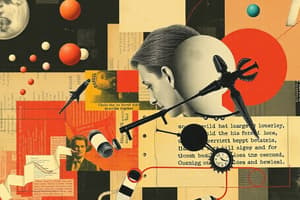Podcast
Questions and Answers
What is the main focus of pharmacodynamics?
What is the main focus of pharmacodynamics?
- Drug metabolism
- Drug effects on biological systems (correct)
- Drug absorption
- Drug distribution
Which concept in pharmacodynamics involves drugs binding to specific receptors to influence cellular function?
Which concept in pharmacodynamics involves drugs binding to specific receptors to influence cellular function?
- Pharmacokinetics
- Receptor theory (correct)
- Drug potency
- Drug efficacy
How is drug efficacy different from drug potency?
How is drug efficacy different from drug potency?
- Efficacy refers to drug absorption while potency refers to distribution.
- Efficacy is related to drug metabolism, while potency is about excretion.
- Efficacy measures the maximum effect a drug can produce, while potency indicates the drug's effectiveness to produce a specific effect. (correct)
- Efficacy is the same as potency in pharmacology.
What does pharmacokinetics primarily focus on?
What does pharmacokinetics primarily focus on?
Which pharmacokinetic concept deals with drug absorption, distribution, metabolism, and excretion?
Which pharmacokinetic concept deals with drug absorption, distribution, metabolism, and excretion?
In pharmacodynamics, what does potency measure?
In pharmacodynamics, what does potency measure?
What is the correct sequence of drug movement in pharmacokinetics?
What is the correct sequence of drug movement in pharmacokinetics?
Which drug classification is based on the drug's primary effects on the body?
Which drug classification is based on the drug's primary effects on the body?
What is the primary purpose of preclinical research in drug development?
What is the primary purpose of preclinical research in drug development?
Which regulatory body approves drugs for human use?
Which regulatory body approves drugs for human use?
In pharmacology, what does the term 'excretion' refer to?
In pharmacology, what does the term 'excretion' refer to?
How does understanding pharmacodynamics and pharmacokinetics contribute to the field of pharmacology?
How does understanding pharmacodynamics and pharmacokinetics contribute to the field of pharmacology?
Flashcards are hidden until you start studying
Study Notes
Exploring Pharmacology 3: Understanding Drug Mechanisms and Applications
Pharmacology encompasses the study of drugs and their effects on living organisms, such as humans, animals, and plants. In this article, we'll dive deeper into the fascinating world of Pharmacology 3, where we'll learn about drug mechanisms and their applications.
Pharmacodynamics
Pharmacodynamics is the study of how drugs interact with biological systems, specifically focusing on the molecular and cellular effects of medications. In essence, pharmacodynamics answers the question: "How does a drug work?"
Two critical concepts in pharmacodynamics are:
- Receptor theory: Drugs exert their effects by binding to specific receptors on cell membranes or within the cell. This binding can increase or decrease the receptor's activity, which, in turn, influences cellular function.
- Drug efficacy and potency: Efficacy is the maximum effect a drug can produce, while potency is a measure of the drug's effectiveness to produce a specific effect. Higher potency means a drug requires a lower dose to produce the desired effect.
Pharmacokinetics
Pharmacokinetics examines the time course of drug concentration in the body following administration, focusing on drug absorption, distribution, metabolism, and excretion (ADME). The pharmacokinetic properties of a drug are crucial because they influence drug safety and efficacy. Pharmacokinetic concepts include:
- Absorption: The drug moves from the site of administration (e.g., oral, injection, or topical) to the bloodstream.
- Distribution: The drug moves from the bloodstream to its target tissue or cells.
- Metabolism: The body breaks down the drug into less active or inactive compounds.
- Excretion: The drug or its metabolites are eliminated from the body through pathways such as urine, feces, or breath.
Drug Classifications
Drugs can be classified in various ways, including by their pharmacologic actions, chemical structure, and therapeutic indications.
- Pharmacologic action: This classification refers to the drug's primary effects on the body, such as agonists, antagonists, and modulators.
- Chemical structure: Drugs can be classified based on their chemical structure, such as alkaloids, antibiotics, and steroids.
- Therapeutic indications: This classification refers to the drugs' primary medical uses.
Drug Development
The pharmacology of drugs encompasses the entire drug development process, from preclinical research through to the approval of safe and effective drugs for human use. The drug development process involves:
- Preclinical research: Testing a drug's safety and efficacy in cell cultures and animal models.
- Clinical trials: Testing a drug's safety and efficacy in humans.
- Regulatory approval: The Food and Drug Administration (FDA) or other regulatory agencies approve the drug for human use.
- Post-marketing surveillance: Monitoring the drug's safety and efficacy in the general population.
Conclusion
Pharmacology 3 builds on the foundations of pharmacology and provides a deeper understanding of drug mechanisms and applications. As you've learned, understanding pharmacodynamics, pharmacokinetics, drug classifications, and the drug development process is essential for a comprehensive grasp of pharmacology. By studying these topics, you'll be better equipped to analyze drugs and their effects on the body, ultimately contributing to the development of safer and more effective therapeutic interventions.
Studying That Suits You
Use AI to generate personalized quizzes and flashcards to suit your learning preferences.



